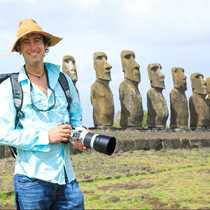Ideal Cove & Petersburg
Today was yet again another beautiful day, spoiling us with sunshine and rich flora and fauna. We awoke to a crystal clear blue sky in Ideal cove. Many guests set out for a hike into the woods in search of forest fun. From the beach, we left behind the tall grasses and intertidal zone, and as we walked deeper, saw the familiar transformation from alders to Sitka spruce, and then to the dense hemlock forest. The trees tower like giants above with beams of sunlight flowing through the bows, illuminating the beautiful understory. For the daring guest taking their eyes from the boardwalk to the flora, a world of macro photography opens up including the dwarf dogwood, mosses, and a variety of colorful fungi. The fresh scent of a forest, the cool air, and sounds of a variety of singing birds, Ideal Cove is a place for all the senses.
We continued our way up the wooden-planked pathway, paralleling a nice stream to our left. As we exited the trees, we came across our first muskeg. Muskegs are fascinating ecosystems which actually make up a large amount of Alaska’s territories. What is a muskeg? To tell the story, we begin with Alaska’s past, a frigid barren landscape covered in thousands of feet of glaciers and ice. Because these glaciers have only recently receded (geologically speaking), the top soil is very thin, met by hard bedrock only a few yards below. Because this bedrock allows no water to pass, and the hemlocks release acids over time, the soil becomes acidic and oversaturated, preventing life for most plants and trees. However, while difficult living conditions prevent certain plants from taking root in the nutrient-poor soils, it opens up the door for other species to adapt to a unique ecosystem. If you can’t get your food from the soil or air – then eat the flesh of an animal that can - this is the story of the sundew. The muskeg has thousands of sundews, whose two species, both seen, are an absolute delight upon closer inspection. Each leaf rises up from a stem to a flat blade containing hundreds of bright-red stalked glands, looking like something from Doctor Seuss’ imagination. Tiny prey is caught in the sticky red hair-like glands, and then digested by the carnivorous plant.
For those of us who chose not to hike, we took a nice zodiac ride along the coast seeing many birds from surf scoters, harlequin ducks, ravens, and we were treated to a large bald eagle nest with one parent present, likely tending to an egg.
This afternoon we made our way to Petersburg, which is a lovely fishing town on Mitkof Island. Here some of us journeyed across the channel and into the forest to find another muskeg. Others stayed and walked the docks learning about local fishing, and getting a very close view of some of the beautiful Alaskan undersea life. Anemones, like the one pictured below, are fascinating animals similar to the sea jellies. Other guests rode along the coast on our fleet of bicycles, taking in the sights and sounds.
We returned to the ship in the late afternoon, surrounded by bald eagles flying overhead, and sailed into the sunset while filling our bellies with our delicious crab feast.
Call +1.800.397.3348 or contact your travel advisor




